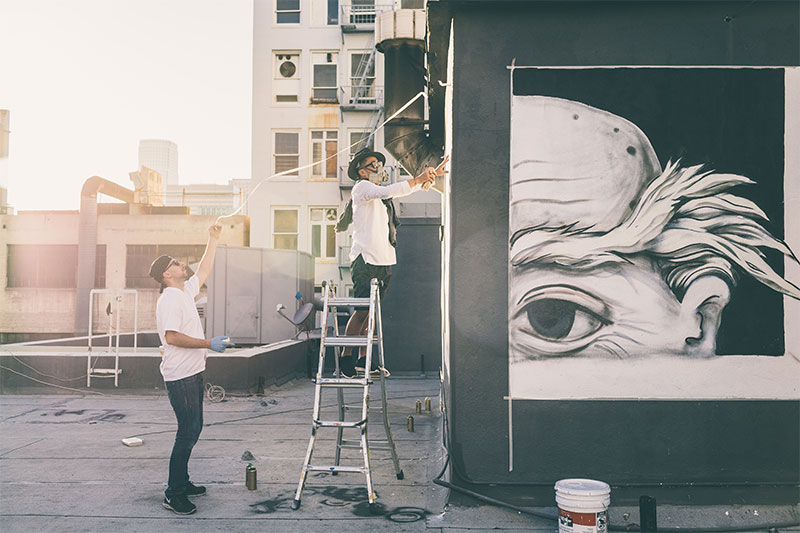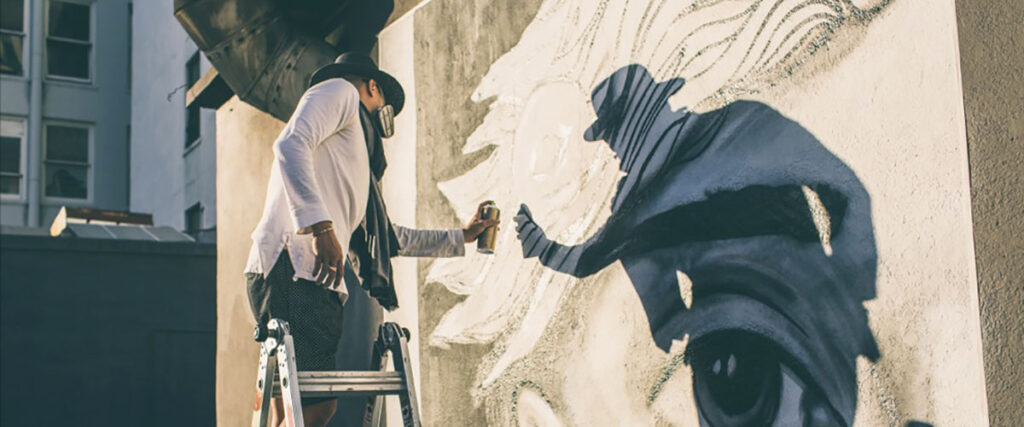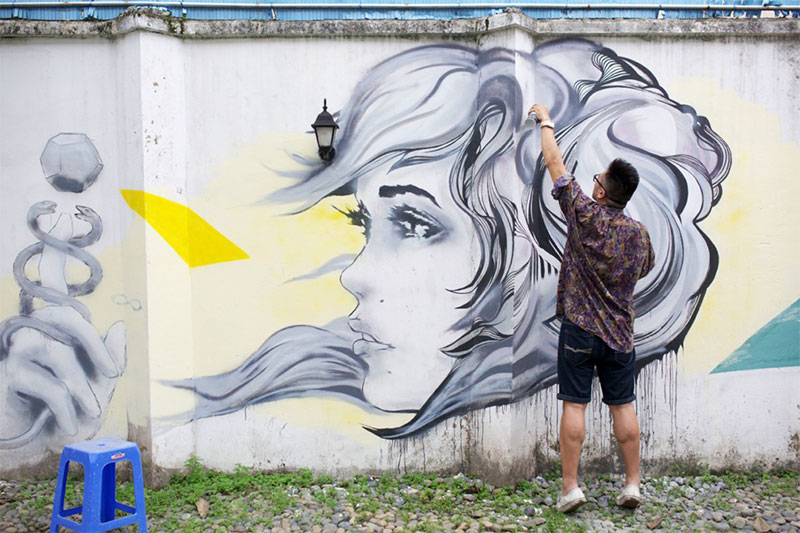Saigon-based graffiti artist Demon Slayer, whose real name is Dan Nguyen, lifts the lid on the growing street art scene in Vietnam.
Dan Nguyen was actually born in the beautiful city of Riverside, California. He moved to Saigon 6 years ago to learn more about his Vietnamese roots and quickly fell in love with the dynamic town. A street artist at heart since his childhood in the states, he quickly starting pursuing a career in the street art world in his new adopted city, forming an integral part of Saigon’s burgeoning street art scene along the way.
Before moving to Saigon, Dan got his artwork displayed at the annual Panama Art Biennial in Central America in 2004, cementing his newfound role as an artist. In 2011, the graffiti artist was commissioned to paint for for a United Nations (UNESCO) project back in 2011. Alongside forging his way on the international scene, however, his concerns run closer to home. We sat down with him to discover his journey from ambitious amateur to game-changing graffiti artist.
Tell us a little bit about how you came to be a graffiti artist.
Growing up in Southern California, you see graffiti everywhere. You could say it permeated into my subconscious at an early age. I never exactly “decided to become a graffiti artist”. Art have always been a part of my life, and I used the street as one of my many ways of communication.

Where did you come to pick up your skills?
In the world of graffiti, you need to seek a mentor who will show you the secrets of the trade and teach you things about the culture. I was lucky enough to be accepted by some of the older and more prominent southern California crews such as CBS who has been painting for 30 years. Back then, you had to be an intern for months before you actually got to touch a spray can and create your first artwork.
Can you tell us a little bit about the street art scene in Vietnam?
Some consider it a form of art, whilst others view it as vandalism. Graffiti in Vietnam is blowing up. A lot of kids in Saigon are extremely passionate about it and picking it up fast, which really sparks some hope for street art in Vietnam.
Why does graffiti have such an unfavourable reputation in some corners?
Not many people realise the true aesthetic value of graffiti and refuse to accept it as a form of art. Graffiti is a way of personal artistic expression and at the same time, it can also express underlying social and political messages. A lot of people have the wrong idea that graffiti is just kids vandalizing personal property. The truth is that graffiti is not an anti-government activity, and it’s not violent or harmful. It’s just art. When people have a better understanding of it, they will come to appreciate what we do.
Can you tell us about your style?
My style is different because it always originates from my authentic ideas and expressions. Not everyone has their own style, some are still trying to find it. It’s a long process that I’ve been cultivating through the decades. I’m an old guy and I’ve been doing this for a long time (laughs).


Do you ever reach out to people about graffiti?
Personally, I don’t reach out to people anymore. When I was younger, I used to do a lot of graffiti educational programs for those who wanted to learn the skills. But I’m not doing graffiti to convince the “anti-graffs” to accept it. It’s art and it’s perceptual. Just like music, books or movies; everyone has their own taste.
What’s the graffiti scene like in Saigon? How has it changed over the years?
When I came here 6 years ago, there was basically nothing on the streets. I only ever came across some stuff by RO and some by DAOS (popular graff artists). Now you can see tags and pieces everywhere. There are even Facebook groups dedicated to the Saigon graffiti community.
In terms of how it’s changed over the years? These days, kids just go online and copy what they see, or go to a paint store where they can easily buy paint, caps, and even guide books for graffiti. They are much more privileged than people my age were when we started out. Before, we had to mix our own paint and hunt down spots to paint. And then, if you didn’t respect others, you would get beaten up.
When you learn from the internet, a lot of the cultural aspects don’t get passed on, and often, young writers get into fights with other writers, since they don’t know the proper “do’s and don’ts”. You’ve got to remember that it’s a global culture that has been around for over 40 years. There’s history, there’s respect, and there’s right and wrong. If you don’t value all those aspects, you are not a true street writer at all.
Can you tell us about some of the street artists and graffiti writers in Saigon that you admire?
In my opinion the best street artists here in Saigon are Liar Ben, Daos, Soor, VietMax, Phat and Kade. For graff, the top of the crop are Suby, Limer, Ger, Sixte, and Rots.
What is your advice for people who want to get started in graffiti?
Basic drawing skills aren’t really needed. What’s needed is typography understanding and techniques when using the can. If you want to start, start with letters first. Just write them with one single color. Don’t go crazy and attempt a 40-color piece. The structure is in the letters. Once you have that down, then you can add the effects. There are writers out there who have great effects but their letter structures are off balance, and it’s really obvious. Font and typography are the most important things. Technique is second. Try practising on a piece of paper first, then go practice on an actual wall.
Can you share with us some of your favorite hangout spots in Saigon?
– Indika has a chilled vibe for a drink, and sometimes they’ve got great live bands playing.
– I also like to chill at Piu Piu, especially on the rooftop. I have also played my DJ sets there many times.
– Hao café: to me, this place has some of the best “café sua da” (milk-coffee with ice) in Saigon.
What does the future hold for graffiti in Saigon?
Graffiti has been around for over 40 years. No one will ever stop criticising it. The word graffiti means “to leave a mark on a surface without permission”, and that’s why it is often connected to vandalism. Once it goes on display in an art gallery, it’s no longer graffiti. As for a better future, there are more and more street murals and writing pieces around in Saigon; which is a good sign.
Details
www.instagram.com/demonslayer__
www.facebook.com/DMNSLYR





